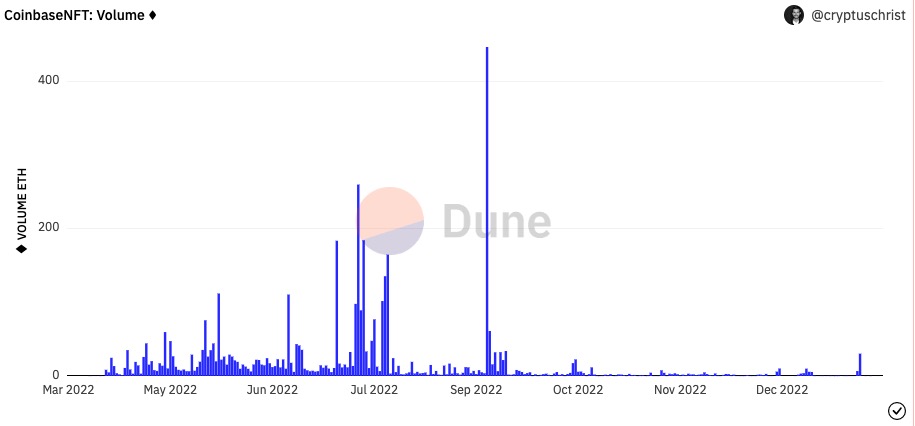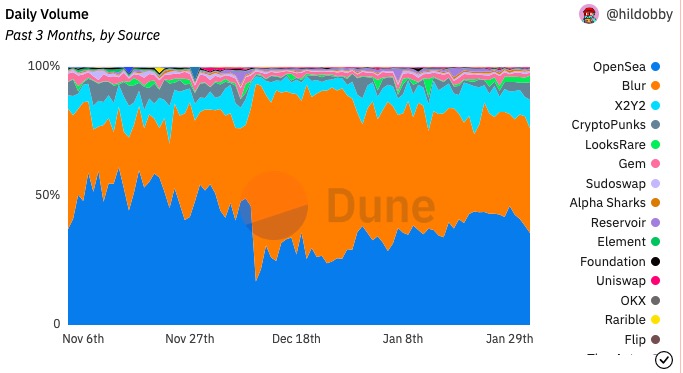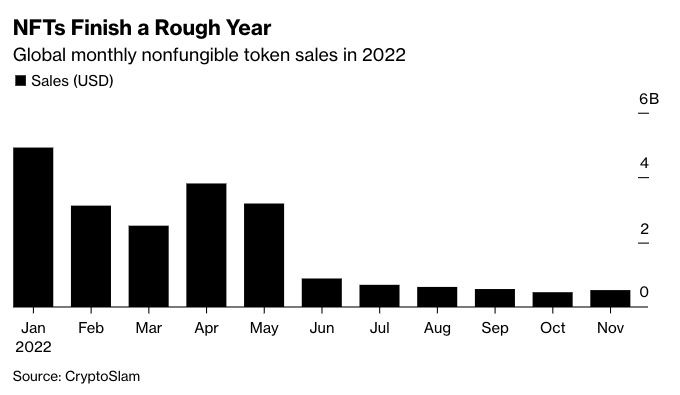After 8 months of going live, the average daily trading volume of the Coinbase NFT market is less than $30,000. What are the reasons behind its cold reception?
Author: Nancy, PANews
On February 2, Coinbase NFT market announced on Twitter that it is suspending the creator Drops feature on its NFT marketplace to focus on other features and tools requested by creators, while emphasizing that it will not shut down the Coinbase NFT market.
In addition to the suspension of some product features, news of content production delays, product team restructuring, and the resignation of the Chief Product Officer, along with unsatisfactory performance in trading volume and user numbers, have cast a huge question mark over the development prospects of the Coinbase NFT market. Despite being backed by the "crypto first stock" Coinbase, its NFT market has not found favorable conditions. This article from PANews will review the market performance of Coinbase NFT since its launch and deeply analyze the reasons for its business struggles.
16,000 Users Completed Only 50,000 Transactions
As a leading platform in the centralized exchange space, Coinbase has a large user base and extremely high market attention, which lays a solid foundation for its expanding business. In October 2021, when Coinbase announced the launch of the NFT trading platform Coinbase NFT, it indeed triggered FOMO in the market. By May 2022, the number of users who applied for registration exceeded 4 million, far surpassing the historical total address count of NFT trading leader OpenSea at that time.
Although Coinbase NFT had a good start, its business performance over the approximately 8 months since its official launch has been unexpectedly mediocre, with very low usage rates, even being "outperformed" by many later entrants.
According to Dune Analytics, as of February 3, the total trading volume of Coinbase NFT was approximately $7.347 million, with over 16,000 users facilitating about 50,000 transactions, averaging less than 200 transactions per day and an average daily trading volume of less than $30,000. In the past 24 hours, its transaction count was only 20, with a trading volume of $306, while on the same day, OpenSea's Ethereum trading volume reached $5.5 million, accounting for 74.8% of Coinbase NFT's historical total trading volume.

Even the NFT market under American game retailer GameStop, which entered the market after Coinbase NFT, achieved a trading volume that was twice that of Coinbase NFT's historical trading volume within just two days of its public beta launch, and within a month, its trading volume exceeded $22 million.
Although the GameStop NFT market also experienced a significant drop in trading volume due to market downturns and ceased data tracking by platforms like DappRadar after partnering with ImmutableX, its performance is clearly better than that of Coinbase NFT, especially considering that Coinbase NFT has more crypto advantages than this traditional gaming giant.
What Are the Reasons Behind the Weak Performance?
The NFT market is no longer dominated by a single player. While OpenSea once firmly held the market throne, many NFT platforms have shaken its status and captured a certain market share with their unique innovative gameplay. According to Dune Analytics, as of February 3, OpenSea's cumulative trading volume over the past three months accounted for 35.7% of the entire NFT market share, while Blur accounted for 40.6%, and X2Y2 for 11%.

Setting aside OpenSea's first-mover advantage, although platforms like Blur and X2Y2 started later, they have still surpassed Coinbase NFT. Despite having strong traffic and funding advantages, Coinbase NFT has not made much of a splash. What are the reasons for this? PANews believes several factors are at play:
1. Launched During a Bear Market, Overall Market is Dismal
The timing of a new product's launch is crucial for its market acceptance. From the announcement of the NFT market in October 2021 to its public availability in May 2022, Coinbase took six months, and upon its official debut, it faced a cooling NFT market. Data aggregator CryptoSlam shows that since April 2022, global NFT sales have been continuously declining, with current trading volume down over 89.9% from the peak of over $4.9 billion a year ago. This means that Coinbase NFT has been operating in a sluggish market environment since its launch, leading to a significant slowdown in trading volume as investor interest in NFTs waned.

In July 2022, an anonymous Coinbase employee also confirmed this factor, stating, "The NFT website launched too late; it went live a year after NFTs peaked, and by then, people had lost interest."
2. Web2 Product Team Did Not Truly Understand Web3
"Coinbase's executives come from the previous generation of companies, like Facebook and Netflix, and they don't understand this emerging market," the aforementioned employee pointed out.
In fact, Coinbase employees had previously anonymously published a petition calling for the replacement of Coinbase's senior management. Although Coinbase CEO Brian Armstrong considered this idea foolish and even stated he would fire the employees who submitted the petition, shortly thereafter, Coinbase announced plans to restructure its product team, which would be divided into four departments, each reporting directly to CEO Brian Armstrong.
Coinbase hired Surojit Chatterjee, a familiar product officer and head of the NFT market, from Google with a hefty salary of $646 million, but he proposed his resignation at the end of October 2022 and officially left on February 3 of this year.
This executive had "cashed out" approximately $105 million worth of Coinbase stock and still retained 249,315 shares of Coinbase stock, which, at the current price of $81.46 per share, is valued at about $20.3 million, far exceeding Coinbase NFT's historical trading volume of 2.7 times.
3. Lack of Unique Strategies
To break OpenSea's monopoly, many platforms have emerged with different strategies to capture market traffic. The Coinbase NFT market, however, entered the NFT space with a social-centric approach and explicitly stated its intention to build a platform that fosters connections between "creators, collectors, and fans." However, for NFT traders, they care more about whether the platform can better support the secondary market and whether it has liquidity capabilities.
Additionally, compared to other NFT trading markets that have launched trading mining, airdrops, royalty cancellations, and order rewards to attract users, Coinbase NFT has fewer unique features. While it supports exclusive releases from popular artists and new crypto-native NFTs, its current suspension of new NFT series launches makes it even harder to attract users. For example, the aggregator platform Blur has captured a significant market share from OpenSea through strategies like airdrops, zero fees, and optional royalties.
Moreover, unlike other trading platforms that support NFTs across multiple blockchains, Coinbase NFT only supports Ethereum-based NFTs. Even when aggregating LooksRare and OpenSea, it still only supports Ethereum NFTs, while NFT ecosystems like Solana and Polygon are also gaining momentum, with trading volumes even surpassing Ethereum. Furthermore, the types of assets supported by Coinbase NFT are far fewer than those on other platforms, limited to collectibles, art, virtual worlds, etc.
4. Business Constraints Due to Compliance
While Coinbase stands out due to its compliance, this very compliance has shackled its business expansion, making Coinbase's NFT business overly "rule-bound" and lacking in innovation.
For instance, after releasing the first part of the short film series "The Degen Trilogy" themed around Bored Ape Yacht Club (BAYC), the Coinbase NFT market faced widespread criticism from the community. As a result, Coinbase suspended the production of the remaining two BAYC NFT short films, stating, "We are continuously improving our content strategy and have decided to pause the production of the remaining two short films while we determine the best creative path forward. We will continue to focus on more direct creative efforts."
In reality, due to the stringent financial regulatory framework in the U.S., Coinbase's business operations require approval from regulatory authorities, and any misstep could lead to regulatory disputes. This is why we see that when Coinbase NFT was first announced, it was only available to a "small portion" of users in the U.S., and its NFT marketing strategy was also quite conventional.
For example, when Coinbase announced its intention to offer interest on account loans, it faced strong intervention from the SEC, prompting Brian Armstrong to unusually tweet 21 times to express his grievances towards the regulatory body, but he received no response. Additionally, Coinbase's 2021 prospectus hinted at the business constraints imposed by regulation, suggesting that unregulated trading platforms would pose "unfair" competition.
These factors have led to a poor performance across various metrics for the Coinbase NFT market. For Coinbase, which is facing significant losses, the NFT market is a crucial layout in its attempt to improve its situation through revenue diversification. It is important to note that Coinbase is currently facing a sharp decline in revenue.
Over the past year, multiple collapses of crypto institutions have drastically reduced trading volumes in the crypto market, leading to a significant drop in Coinbase's revenue in 2022. Brian Armstrong revealed that the company's revenue for that year was at least "cut in half," and its stock price also experienced a substantial decline. Credit rating agency Moody's even downgraded Coinbase (COIN)'s long-term credit rating and its secured senior unsecured notes, citing "a significant weakening in revenue and cash flow generation capacity." As a result, Coinbase has also undergone multiple rounds of significant layoffs to reduce expenses.
Most of Coinbase's revenue comes from crypto trading fees, and the instability of this income has led it to seek diversification to reduce this dependency, which is why the Coinbase NFT market initially adopted zero fees and plans to start charging fees according to industry standards in the future.
In fact, the rapid increase in trading volume and trading value in the NFT market has also led to a surge in profits for the industry. For example, OpenSea's total trading volume currently stands at $15.3 billion, resulting in a total trading fee revenue of $382 million for the platform. Consequently, Brian Armstrong has even optimistically predicted that the scale of Coinbase NFT's new business "could be as large as its core cryptocurrency trading business, or even larger."
Just like the battle between Yahoo and Google in the Web2 world, in an attempt to compete with Google, the then-leading search engine Yahoo tried to upgrade its technology by directly inserting information like maps, yellow pages, and weather forecasts into search results to combat competitive pressure. However, "just because Yahoo has a search box doesn't mean they are Google."
In the crypto world, although Coinbase holds a dominant position in CEX and has taken significant steps in the mainstream market, this does not necessarily benefit its diversified crypto business expansion. Instead, operational strategies and technological paths have become the key to competition.










